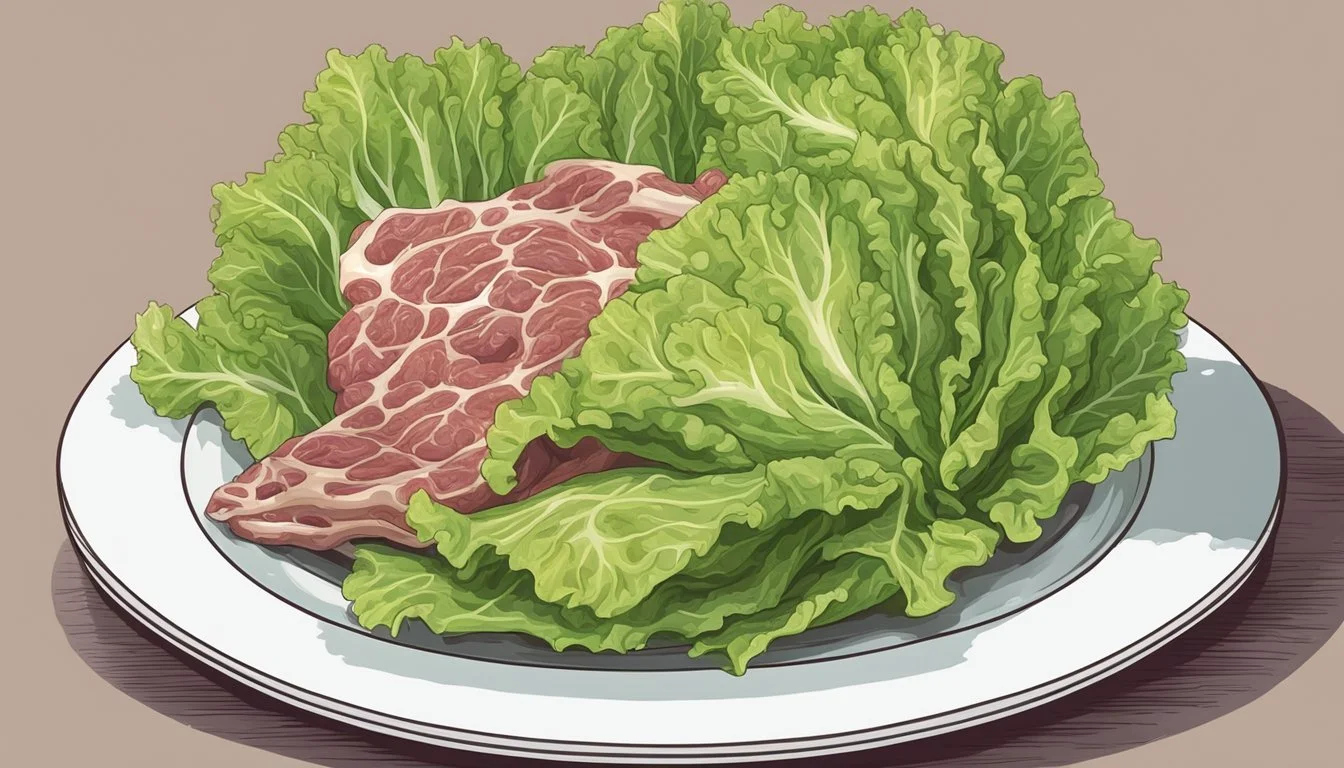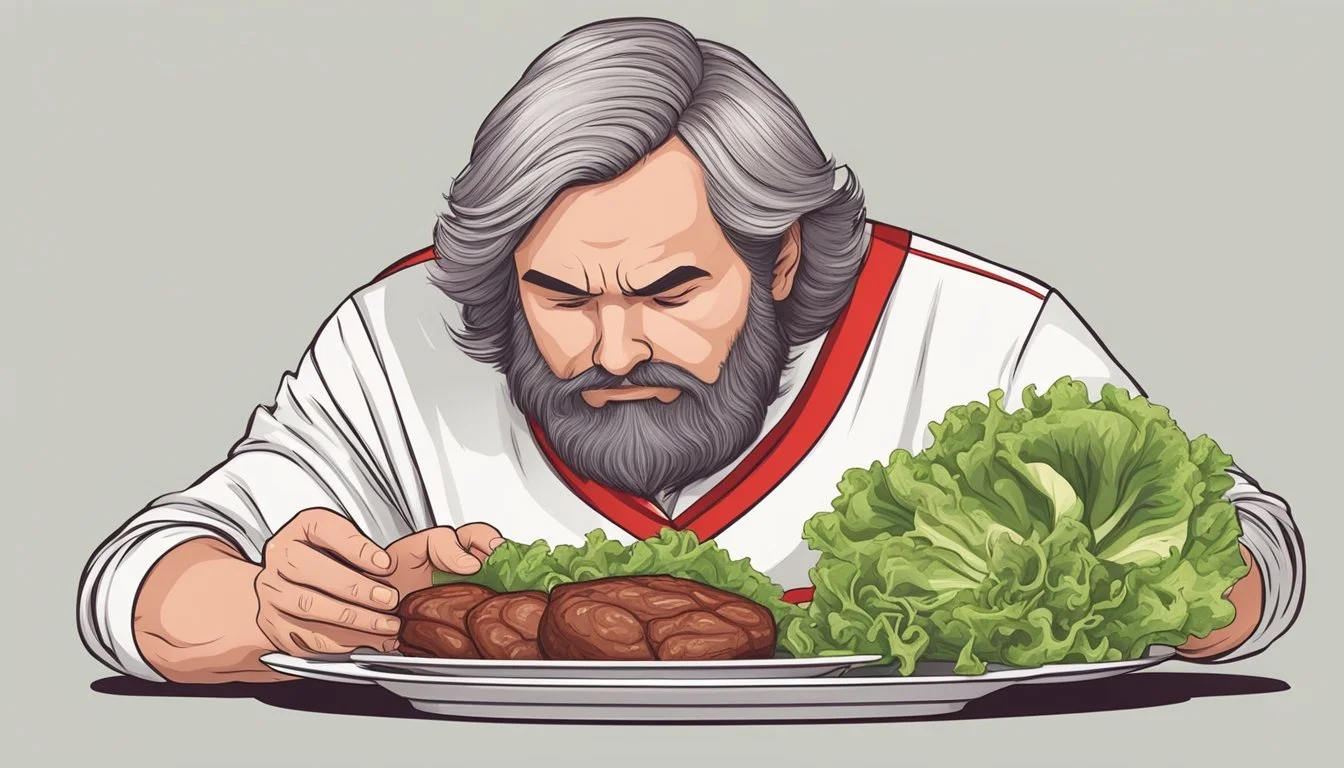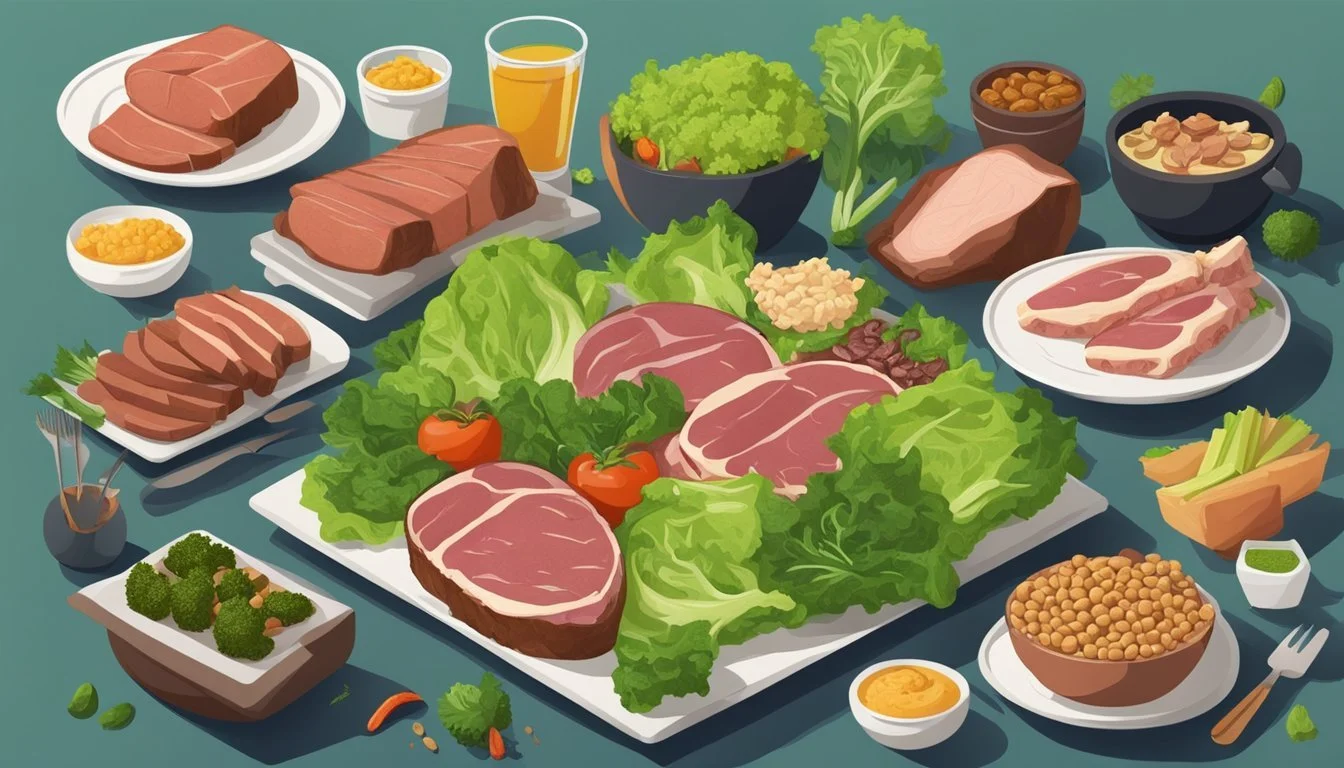Can You Eat Lettuce on Carnivore Diet
Understanding Dietary Restrictions
The carnivore diet, characterized by an intake exclusively of animal products, has gained notoriety in nutritional circles. It advocates for a meal plan centered around meats, seafood, eggs, and select dairy products, while plant-based foods are generally excluded. As proponents tout the benefits of this diet, from weight loss to simplified meal planning, a question often arises regarding the inclusion of certain vegetables, such as lettuce.
Lettuce, with its minimal calorie and carbohydrate content, is a subject of debate within the carnivore diet community. Some purists might argue that the diet should strictly consist of animal-derived foods without exceptions. However, variations of the diet appear to allow minimal consumption of plant matter like lettuce. This contradiction stems from individual interpretations of the diet and personal dietary goals, leading to a spectrum of adherence levels within the carnivore community.
Individuals considering the carnivore diet or those already practicing it may contemplate if they can incorporate lettuce into their meals. While the foundational principle of the carnivore diet excludes plant foods, including leafy greens, allowances for certain plant-based items like lettuce are seen in some iterations of the carnivore diet. It is not typically a staple, but it may be occasionally included for those looking for variety or a slight departure from an otherwise strict carnivorous regimen.
Essentials of the Carnivore Diet
The Carnivore Diet is distinct in its rigorous emphasis on animal-derived foods and the exclusion of plant-based foods. Understanding its core principles is crucial for those considering this dietary approach.
Fundamentals of Meat-Only Diet
Primary Components: The Carnivore Diet centers on the consumption of meat and other animal products. It proposes that individuals should derive their nutritional intake predominantly from these sources.
Meat Varieties: Fatty cuts of meat such as beef, pork, and organ meats are encouraged. These are not just sources of protein but also provide essential fats.
Seafood: Including a variety of seafood provides essential nutrients like omega-3 fatty acids.
Eggs and Dairy: Eggs are a staple in this diet due to their high nutrient content, while certain dairy products, particularly high-fat options like cheese and butter, may be included.
Nutrient Density: Animal products are known for being nutrient-dense, providing a wide range of vitamins and minerals necessary for body function.
Excluded Foods in Carnivore Diet
Plant-based Foods: All plant-based foods are systematically eliminated in the Carnivore Diet. This includes:
Vegetables and Fruit: Broadly omitted due to their carbohydrate content.
Grains and Legumes: These are viewed as sources of antinutrients and are not consumed.
Sugar and Processed Carbs: Highly processed foods high in sugar and carbs are eliminated.
Carbs and Fiber: The diet minimizes carbohydrate intake and does not consider dietary fiber as necessary. Proponents suggest that the absence of fiber does not adversely affect digestive health when consuming a meat-only diet.
Health and Nutritional Considerations
When considering the carnivore diet, one must carefully evaluate its impact on health and nutrition. The diet's emphasis on animal-based foods offers particular nutrients and potential health benefits while also posing risks of nutrient deficiencies.
Potential Benefits of Carnivore Diet
The carnivore diet is rich in protein and fats, which are essential for maintaining muscle mass and providing energy. It primarily includes meat, seafood, eggs, and some dairy products; foods that are naturally high in vital minerals like iron and zinc. This diet also supplies B-vitamins, crucial for energy metabolism and nervous system health.
Health benefits can include a reduction in inflammation, as some proponents report lower levels of inflammatory markers. Additionally, the elimination of plant-based foods can sometimes lead to a simplification of digestion processes for individuals who may have difficulties digesting certain plant fibers.
Risks and Nutrient Deficiencies
However, the carnivore diet lacks certain essential nutrients found in plants. One notable example is vitamin C, which is crucial for the immune system and skin health. While meat can contain some vitamin C, the levels are much lower than those found in fruits and vegetables.
Furthermore, a lack of variety in food choices can lead to deficiencies in certain vitamins and minerals. For example, the carnivore diet typically lacks fiber, which is important for gut health.
Long-term adherence to this diet may also increase the risk of health issues related to the excessive intake of saturated fats and cholesterol. There has been concern about the potential impact on heart health and the possible development of chronic diseases over time.
In summary, while the carnivore diet can provide key nutrients from animal products, its restrictive nature may also lead to significant nutritional gaps that require careful management.
Skip the lines and order your fiber supplement online for a stress-free shopping experience!
Carnivore Diet Food List
In adhering to a carnivore diet, individuals focus on animal products exclusively, eliminating all plant-based foods. This section outlines the types of meats and dairy products generally consumed on this diet.
Types of Meat and Animal Products
The carnivore diet centers on a diverse array of meat types and animal products, each presenting unique nutritional profiles:
Beef: All cuts are included, with a preference for fatty portions like ribeye, which is rich in fats critical for energy.
Pork: Options include bacon, pork belly, tenderloin, and other cuts, focusing on high fat content.
Chicken: From chicken breast, a lean protein source, to fattier cuts like thighs, all parts of the chicken are acceptable.
Seafood: Fatty fish such as salmon, mackerel, and tuna provide omega-3 fatty acids, while shrimp, sardines, and oysters are also excellent choices.
Organ Meats: Liver and other organ meats are heralded for their nutrient density and are staples of the diet.
Other meats: Lamb, bison, and other animal meats are consumed for their rich protein and fat content.
Types of Meat/Animal Products and Their Description
Beef (e.g. ground beef, ribeye)
Description: A primary source of protein and fat; various cuts are included.
Pork (e.g. bacon, pork belly)
Description: A diverse range for high-fat content and flavor.
Chicken (whole cuts)
Description: Includes all parts of the chicken, with different fat contents.
Seafood (e.g. salmon, tuna)
Description: Important for omega-3s and other vital nutrients.
Organ Meats (e.g. liver)
Description: Nutrient-dense parts of animals.
Dairy Inclusion and Exclusion
Dairy is often included in the carnivore diet to varying degrees, guided by individual tolerance and preference:
Cheese: Full-fat varieties are preferred; included as a source of fat and flavor.
Heavy Cream: Used in small quantities for coffee or recipes.
Butter: Pure butter is commonly used for cooking or as an additional fat source.
Individuals may choose to exclude or limit dairy due to personal sensitivities or to maintain strict adherence to meat-only variations of the diet.
Dairy Product Inclusion/Exclusion Criteria on a Carnivore Diet
Cheese
Criteria: Full-fat types, used for increased fat intake.
Heavy Cream
Criteria: Occasionally used for variety in the diet.
Butter
Criteria: Common for cooking and added fats.
Foods like eggs are also integral to the carnivore diet due to their high-quality protein and fat content. In contrast, dairy products like yogurt may be excluded due to sugar content or for a stricter interpretation of the carnivore philosophy. It's essential for individuals to personalize their dairy intake based on their own health responses and dietary goals.
Lettuce on a Carnivore Diet
When considering the carnivore diet, individuals typically focus on exclusively consuming animal products such as meat, seafood, eggs, and certain dairy items. The primary goal is to eliminate plant-based foods, which means that lettuce, as a leafy green, usually would not be included in a strict carnivore diet.
However, some variations of the diet do allow the inclusion of certain plant matter. Lettuce may be consumed in moderation within these less strict adaptations of the carnivore diet. It's important to acknowledge that lettuce is a leafy green vegetable low in calories and carbohydrates.
Nutritional Profile of Lettuce:
Calories
Content: Very low
Carbohydrates
Content: Low
Fiber
Content: Present
Micronutrients
Content: Contains vitamins & minerals
For individuals who strictly adhere to a zero-carb dietary regime or have goals that require strict adherence to animal products only, lettuce does not align with the carnivore diet guidelines. They maintain a regimen that excludes lettuce to remain within the confines of the dietary principle that focuses on animal-derived nutrients.
In summary, incorporating lettuce into a carnivore diet is dependent on the individual's dietary approach within the carnivore spectrum. Traditionalists avoid lettuce due to its plant origins, while more flexible carnivores might include it as a minor part of their diet. It is the dieter's responsibility to decide if they wish to adhere strictly to animal products or to allow some exceptions, like leafy greens, in their consumption.
Implementation Strategies
When adopting a carnivore diet, individuals must strategize to ensure a successful transition and create sustainable meal plans. Tailoring these strategies to incorporate only animal-based foods is essential for adherence to the diet.
Transitioning to Carnivore Diet
Transitioning to a meat-only diet requires a gradual elimination of plant-based foods to minimize withdrawal and adaptation symptoms. Individuals often start by introducing a higher quantity of meats and animal products at each meal, while phasing out vegetables, fruits, and grains. It's beneficial to monitor the body's response to reach full ketosis—a state where the body burns fat for fuel instead of carbohydrates.
Week 1-2: Increase meat consumption at breakfast, lunch, and dinner while reducing plant-based foods.
Week 3-4: Remove all plant-based foods and observe how the body adjusts to a full meat-only diet.
Staying hydrated and maintaining electrolyte balance is crucial during this period.
Meal Planning and Recipes
For those on the carnivore diet, planning meals revolves around animal products, ensuring a variety of meat types to cover a range of nutrients.
Breakfast might include a beef steak or eggs cooked in butter.
For lunch, one might opt for a pork chop or chicken thighs.
Dinner could be fatty fish like salmon or a lamb roast.
Snacks, though less common on this diet, can include jerky or small portions of cheese.
In terms of recipes, simplicity is key: seasoning with salt and cooking meats to the preferred level of doneness will suffice. Grilled, baked, or pan-fried meats are all valid options:
Grilled salmon: Season with salt and grill until flaky.
Beef steak: Pan-sear with salt for a crusty exterior.
Preparation should focus on high-fat cuts to maintain energy levels and stimulate ketosis for sustained success on the diet.
Carnivore Diet and Lifestyle
Adopting a carnivore diet often means making significant changes to one's eating habits and lifestyle, which can have implications for social interactions and physical activities. A strict focus on animal-based foods aims at what some believe to be optimal health and energy levels, but it requires careful consideration of both social settings and exercise routines.
Managing Social and Lifestyle Changes
The carnivore diet significantly narrows the range of acceptable foods, which can make social dining and gatherings a challenge. People may find themselves explaining their dietary choices frequently, and it can sometimes be difficult to find suitable options when eating out. They should be prepared to navigate these social scenarios while adhering to their dietary principles. Moreover, the diet can affect one's lifestyle by potentially simplifying meal planning and preparation since the diet is limited to animal products.
Exercise and Physical Activity
Exercise remains an important aspect of a healthy lifestyle, even when following a carnivore diet. People often report increased energy levels on the diet, which can enhance physical performance and recovery. However, the body might require an adaptation period, during which exercise intensity and volume might need to be adjusted. It's also vital to listen to one's body and possibly consult with a healthcare provider to ensure that any exercise regimen is balanced with the diet for optimal health.
Common Additions and Restrictions
When adhering to the carnivore diet, individuals focus on consuming animal-based foods but may consider adding certain beverages, condiments, and plant matter. The diet’s foundation is based on simplicity and the removal of plant-based foods, yet there are nuanced allowances.
Beverages and Condiments
Beverages:
Tea and coffee are commonly consumed for their stimulating effects. They contain minimal calories and carbs, aligning with the low-carb approach.
Alcohol is typically avoided due to its sugar content and potential to disrupt ketosis, a metabolic state desired by some carnivore dieters.
Condiments:
Spices and herbs may be used sparingly to enhance flavor, although strict adherents avoid them.
The use of condiments is limited, with a preference for those that are low-carb and do not trigger inflammatory responses.
Acceptable Additions
Plant-based foods: While the core of the diet is animal products, some individuals incorporate:
Limited amounts of leafy greens like lettuce considering their low calorie and carbohydrate content, which can be suitable for a keto approach and provide dietary variety without significant deviation from the diet’s principles.
High-fat, low-carb plant derivatives, such as avocados or olives, may occasionally be included to increase the diversity of fats.
This section adheres to the foundational concepts of the carnivore diet while acknowledging that dietary practices may vary among individuals seeking health optimization through a carnivore or ketogenic lifestyle.
Considering a Holistic Approach
When exploring the compatibility of foods like lettuce with the carnivore diet, it's essential to examine the nutrient balance and the guiding principles that characterize the diet.
Balancing Macronutrients and Micronutrients
The carnivore diet, centered on the consumption of animal products exclusively, typically lacks representation from plant-based food groups, which can influence the intake of micronutrients. Proteins and fats are abundant in animal products, providing essential amino acids and fatty acids. These nutrients are crucial for building and repairing tissues and producing hormones and enzymes.
Proteins: Found in meats, seafood, and eggs.
Fats: Available in meats, particularly fatty cuts, and in products like butter and certain cheeses.
In contrast, consuming carbohydrates is significantly diminished, as plant-derived foods like grains, legumes, and vegetables are minimized or eliminated. This includes lettuce, which is primarily composed of water and carbohydrates. Although low in calories, lettuce provides certain vitamins and minerals that can complement the carnivore diet's focus on macronutrients with additional micronutrients. For instance:
Vitamins: Lettuce contains vitamins such as vitamin K and vitamin A.
Minerals: It can offer minerals like potassium.
Whole-Animal Eating Philosophy
One of the principles of a holistic carnivore diet is the consumption of the whole animal, which includes organ meats and bone marrow — prized for their dense micronutrient content. Here's what they provide:
Organ Meats: These are nutrient powerhouses, rich in vitamins and minerals, such as B vitamins, iron, and selenium.
Bone Marrow: It's a source of fats and micronutrients like collagen.
This philosophy encourages the intake of a variety of animal-derived foods to ensure a comprehensive spectrum of nutrients while maintaining adherence to the diet's framework.
Special Considerations and Adaptations
When adopting a carnivore diet, individuals must consider personal health conditions and potential allergic reactions. Responsible adaptations of the diet may include incorporating specific non-meat items on a limited basis.
Individual Health Conditions
Individuals with certain health conditions may need to modify the strictness of the carnivore diet. For someone with digestive issues or metabolic disorders, introducing leafy greens such as lettuce in small quantities could provide dietary fiber without adding significant carbohydrates. However, this practice should be viewed as a restrictive adaptation of the carnivore diet, and one should monitor their health responses closely.
Allergies and the Elimination Diet
The carnivore diet inherently functions as an elimination diet, which excludes potential allergens found in plant-based foods. For individuals with unidentified food allergies, starting with a meat-only approach and then carefully reintroducing plants like lettuce can help in identifying triggers. It is crucial to:
Start with animal products only.
Gradually reintroduce plants, such as lettuce.
Keep a dietary journal to track reactions.
Adhering to an elimination protocol, some may experience health benefits such as the reduction of allergic symptoms. However, maintaining a balanced nutritional profile is essential, and any diet changes should be discussed with a healthcare professional.
Carnivore Diet in the Long Term
Evaluating the Carnivore Diet for extended periods involves examining both its feasibility regarding environmental sustainability and the possible health outcomes associated with long-term adherence.
Sustainability and Environmental Impact
The Carnivore Diet, focusing solely on animal products, has sparked discussions about its environmental viability. Critics argue that high meat consumption can lead to increased greenhouse gas emissions and resource depletion, as animal farming is generally more resource-intensive than plant farming. Proponents may cite the potential for sustainable farming practices, such as regenerative agriculture, yet the scalability of such practices when applied to a diet devoid of plant matter remains a point of contention.
Greenhouse gas contributions per food category:
Meat production: High emissions, especially in beef and lamb farming.
Plant agriculture: Generally lower emissions, with variations among different crops.
Resources required per pound of product:
Water: Animal products typically require more water than crops.
Land: Livestock requires grazing land, which contributes to deforestation and habitat loss.
Long-term Health Effects
The health implications of the Carnivore Diet over a prolonged period are a subject of ongoing debate among experts. Short-term weight loss is often reported, but comprehensive long-term studies are lacking. Concerns emerge regarding potential nutrient deficiencies, given that the diet excludes fruits, vegetables, and grains, all sources of essential vitamins, fiber, and phytonutrients.
Nutritional considerations:
Potential vitamin deficiencies (e.g., Vitamin C).
Lack of dietary fiber, which is essential for gut health.
Possible health outcomes:
Initial weight loss may occur owing to reduced carbohydrate intake.
Long-term effects include concerns over cardiovascular health due to high saturated fat consumption.
While anecdotal accounts suggest individual success stories, many nutritionists highlight the importance of a balanced diet including both animal and plant-based foods for optimal health. Further research will help to clarify the efficacy and safety of the Carnivore Diet over time.












